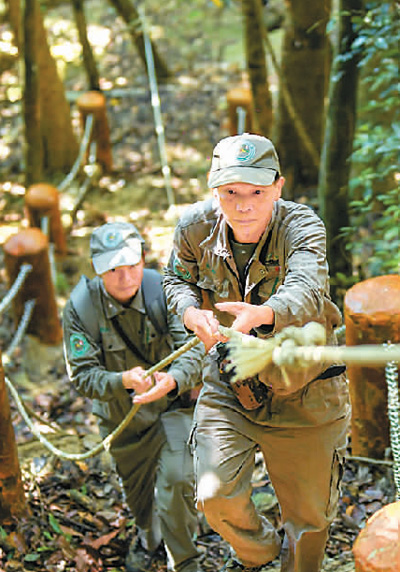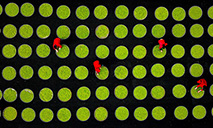Hainan Tropical Rainforest National Park reports remarkable achievements in ecological conservation
The Hainan Tropical Rainforest National Park in south China’s island province of Hainan has witnessed continuous improvements to its ecological environment and the harmonious coexistence between man and nature in recent years, thanks to the province’s efforts in stepping up ecological conservation and making innovations to its protection system.

File photo shows the scenery in the Bawangling nature reserve, part of the Hainan Tropical Rainforest National Park in south China’s Hainan Province.
The national park boasts one of the most concentrated, best-preserved and largest contiguous tropical rainforests in China and is a key area for biodiversity conservation in the country and the world at large.
The national park includes the only habitat for Hainan gibbons, the world’s most critically endangered primates and a flagship species in Hainan.
The population of wild Hainan gibbons was fewer than 10 in the 1970s. Back then, the species was found only in the Bawangling nature reserve, which is now a part of the current national park. So far, there are 35 gibbons in five families, compared with only 13 gibbons in two families in 2003, official data has shown.
The steady growth of the population of Hainan gibbons shows that the primate species enjoys favorable conditions for breeding, with their living environment and status steadily improving, while the wild animal’s natural ecological habitat has undergone further restoration and expansion, according to a staff member with the Hainan Institute of National Parks.
These achievements were made possible thanks to Hainan’s consistent efforts in promoting ecological conservation. In January 2019, the province set up a pilot area for the tropical rainforest national park in order to better protect and restore the ecosystem. The pilot area, located along the central mountainous terrain of the province, covers an area of more than 4,400 square kilometers and encompasses several nature reserves.

Photo shows forest rangers in the Hainan Tropical Rainforest National Park in south China’s Hainan Province. (Photo/Wang Chenglong)
Since then, Hainan has strengthened the protection and restoration of the habitat for the gibbons by implementing measures such as strengthening routine monitoring and planting native tree species that the gibbons use to collect food.
Wang Jinqiang, now 55 years old, is a member of the Bawangling nature reserve’s Hainan gibbon monitoring team. He and his colleagues live in the mountains for at least five days every month in order to track these gibbons. “Our monitoring indicates that the range of activities of the gibbons is expanding,” the man said.
Wang explained that they have planted more than 10,000 trees for the gibbons since late July 2021.
Meanwhile, Hainan has enhanced its scientific research capabilities aimed at the protection of the gibbons. Over the past years, the province has established the Hainan Institute of National Parks, a gibbon protection and research base, and a long-term mechanism for conservation research.

File photo shows a Hainan gibbon, the most endangered of all gibbons and the world's rarest primate, in south China’s Hainan Province.
The sound protection of Hainan gibbons epitomizes Hainan’s efforts in ecological conservation. Over the past two years, the province has been actively exploring a model for building national parks with Chinese characteristics and pushing forward the construction of the tropical rainforest national park by putting in place an efficient management system, making innovations in operational mechanisms, reinforcing supports and enhancing supervision and management activities, said Huang Jincheng, director of the Hainan Tropical Rainforest National Park Administration.
To better protect the national park, the provincial government issued a document that launched a project for relocating villagers from core protected areas in 2019.
Gaofeng village was once a poverty-stricken village in the central part of the Yinggeling national nature reserve, which is a part of the national park, in Baisha Li Autonomous County. At the end of 2020, 498 people from 118 families in the village were relocated to a resettlement community to make way for the national park. Each family in Gaofeng has been allocated a house of 115 square meters at the resettlement community, and each villager has an average 10 mu (about 0.67 hectares) of land on a rubber plantation. Besides, with a thriving edible fungi industry and improved infrastructure and public services, villagers now lead a better life at the resettlement community. The government plans to relocate all 1,885 people from 470 households inside the core areas of the tropical rainforest by the end of this year.
Thanks to the improving ecological environment in the national park, an increasing number of new species have been discovered there. Between 2019 and 2020, nine plant species, five animal species, and five macrofungi species were newly discovered in the national park. In March, researchers from the Chinese Academy of Tropical Agricultural Sciences said they had discovered eight new macrofungi species in the national park.
“Hainan will continue to strengthen the comprehensive protection of its tropical rainforests, and put 20 nature reserves, which were originally separated from one another, under integrated management and protection,” Huang Jincheng said.
Photos
Related Stories
- Farmers embrace bumper harvest in Hainan
- New birth of Hainan's "mother river"
- China's Hainan to install 20,000 charging piles in 2022
- Aerial view of litchi flowers in Haikou, Hainan
- China's Hainan sees foreign trade climb 72.4 pct in Jan-Feb
- A look at local fruit market in Haikou, Hainan
- Explore ecological diversity of Hainan Island on World Wildlife Day
- First discovery of prehistoric rock painting in China's tropical Hainan
- Coconut carvings shape villagers' prosperous lives
- Traditional sugar-making proves to be lucrative business in China's Hainan
Copyright © 2022 People's Daily Online. All Rights Reserved.










